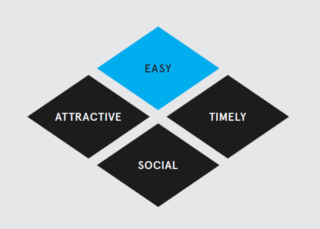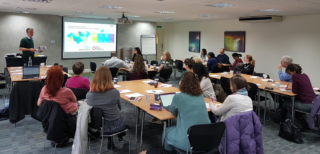Behavioural insights help us to better understand factors that influence behaviour of patients and healthcare staff as well as those of the general public. These can be utilised to help us create more sustainable healthcare by reducing inefficiency and waste.
These insights have been used across healthcare to generate low cost interventions to improve service outcomes. Many of them may seem like common sense which is exactly what they should be!
Here are two examples where behavioural insights have been applied in healthcare:
- A really simple and low-cost solution to ‘nudge’ staff behaviour I heard of recently involved installing a shelf near to the sink to encourage handwashing on wards. Insights found a barrier to staff not using it was that their hands were full carrying notes, equipment, medications etc. and needed a place to put things down to be able to wash their hands.
- A fantastic patient-focussed piece of work that is proven to have a cost effective impact in reducing violence and aggression in A&E departments by improving patient experience. It involved informing and guiding patients through their time in the department using signage, leaflets and digital platforms. The initiative also involved working with frontline staff through reflective practices to support their interactions with frustrated and aggressive patients. I highly recommend checking out A Better A&E toolkit to learn more about this one.
Simple Ways to Apply Behavioural Insights
Nudging, incentivising, adjusting environments or implementing low-cost innovative solutions to bring about and sustain behaviour change should be made Easy, Attractive, Social and Timely (EAST). These four simple principles for applying behavioural insights are based on the Behavioural Insights Team’s work and wider academic literature. The framework’s handbook, EAST: Four Simple Ways to Apply Behavioural Insights, is available to download for free.

To give an understanding how EAST can be applied to a behavioural intervention, I will use the example of a super new app called Medishout, developed to eradicate ward inefficiencies and save money for hospitals, a simple solution created by orthopaedic registrar Ashish Kalraiya. The app allows frontline staff to systematically report problems in real time by selecting the ward where the issue occurs and a free text box to describe the problem. This intervention fits the EAST model in respect the following:
Easy: it reduces the ‘hassle’ factor of having to find the right channel to report a problem, as the app is coded to do that for them and they can take a picture of the problem and report the issue on the same device. The issue is then sent to the inbox of the right person or team be it the matron, IT department or domestic services.
Attractive: the app is intuitively attractive as it means that issues and suggestions for procedural improvements can be addressed enabling the staff member to do their job more effectively.
Social: the app’s functionality enables the user to connect their issue with the right person. To enhance the social element, it could include push notifications to inform users what problems have been reported and by whom, informing others their peers have performed the desired behaviour of reporting issues nudging them to do so. The app could also include a forum function that provides a potentially useful insight creator, enabling users to collaboratively address identified issues and challenges.
Timely: this is the USP for the innovation, people can report the problem in real time avoiding the risk of forgetting to report later on when they are at a computer, a reporting behaviour that promotes and encourages the need for the issues raised to be addressed promptly.
When considering applying behavioural insights to your own work, give consideration to it may not always be appropriate to use all steps of EAST. As some interventions may require the use of only one or two steps of the framework to bring about the desired behaviour change.
Fast and slow thinking
Daniel Kahneman in his book Thinking, Fast and Slow explains how we use our thought processes, System 1 (fast: automatic/unconscious) we use much more than we think, making thousands of decisions using this system daily without even realising. System 2 (slow: rational/reflective) of our brain is conscious, uses logical thinking that takes effort and depletes energy stores. Kahneman highlights a high quality study Extraneous factors in judicial decisions, that found prisoners are much less likely to be granted parole if hearings are before lunchtime or a snack break. After breaks, where energy levels are restored, the number of favourable decisions for parole jumps up.
To bring about change, appeal to the inner Homer Simpson
People think they are rational and reflective people, however, System 1 is frequently in control of our decision-making. Healthcare is complex and requires a vast amount of System 2 thinking, yet when people are tired they tend to revert back to relying on System1.
Many of us have gone into a shop with the best intentions of getting a healthy snack and without realising it, System 1 kicks in and you’ve bought the 2-for-£1 chocolate on offer at the checkout before even realising what you’ve done.
Simon Steven’s has been leading a charge to get hospital caterers and onsite shops to help people make healthier choices by appealing to their System 1 brain by swapping unhealthy offers for healthy options like fruit at checkouts, removing advertising of unhealthy food and drink, stopping the sale of super-size confectionery and sugar-sweetened beverages and introducing tactics to make healthier options the easier choice like including only water and fruit as part of meal-deals.
Behavioural insights bridges the gap between what we know we should do and doing it. Too often we try to train away the problem, lets simplify the process and appeal to the Homer Simpson brain in us.

Special thanks go to Daniel Berry, H + K Strategies, for facilitating two workshops for Q members about applying behavioural insights to healthcare improvement. You can download the toolkit and worksheet developed for these sessions by clicking the links.
- You can join Q’s ‘ Applying Behavioural Insights in Healthcare’ group here (open to all).